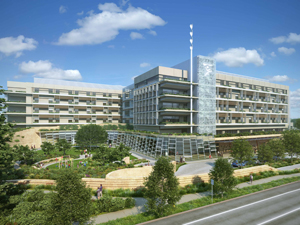September 10, 2012 - By Ruth Schechter

A rendering shows Packard Children's after completion of the expansion that will more than double its size.
About 200 hospital employees, volunteers, administrators, planners, business leaders, elected officials and community members wearing bright yellow hardhats gathered under a white tent near the excavation site next to Lucile Packard Children's Hospital on Sept. 6 to celebrate the official groundbreaking of its long-planned expansion.
While "make-ready" activities have been under way for the past year, the groundbreaking marks the formal start of construction. The $1.2 billion project will add 521,000 square feet to the approximately 300,000 square-foot existing hospital, streamlining diagnosis and treatment, and catering to the unique health-care needs of children and their families.
"I want to acknowledge the tremendous work that takes place here every single day," said Packard Children's president and CEO Christopher Dawes. "It's the patients, families and staff who inspired us to build this hospital so that we can take care of the most complex needs and provide true family-centered care."
Scheduled to open in 2016, the new building will optimize the hospital's services and infrastructure, adding more beds, private rooms, state-of-the-art operating suites, family-friendly amenities and the flexible floor space the hospital needs to adapt to new technologies and to provide more efficient services. The expansion will add capacity for 104 new beds, creating a total of 361 beds onsite, while more than doubling the current square footage.
Although the children's hospital goes back almost a century, the current facilities were constructed in 1991. Since then technology has changed dramatically, as have the needs of the patients who come to Packard Children's for care.
"The new hospital has been designed not only for our patients today but also for what we anticipate their needs will be in the future," added Dawes. "The new hospital will incorporate the very latest diagnostic capabilities with the flexibility to change as technology changes while also providing more privacy and more space for families."
The added space also means that the hospital will no longer need to turn patients away for lack of beds.
Private rooms will have fold-out double beds so both parents can stay overnight, with amenities for comfort and privacy. They also are designed for safety and infection control, with supplies consolidated in the in-room nurse workstation and a sink by the door for hand washing.
Seven new operating rooms (with space to add more) will cut down on scheduling delays and wait time when surgeries go longer than planned. Two of the ORs are specialized hybrid rooms with state-of-the-art diagnostic MRI and angiography imaging equipment fully integrated into the surgical suite.
Increased demand for the unique services Packard Children's provides has meant that, over the years, space formerly used for storage, offices and break rooms has been converted to meet clinical needs. The expansion will feature not only amenities dedicated to family needs — such as private rooms, quiet waiting areas and age-appropriate playrooms — but also space designed to make work more streamlined and effective, such as centralized meeting rooms, adjacent storage for medical supplies, outdoor break areas just for staff and onsite locker rooms and showers.
More than $250 million has been contributed toward the project by local philanthropists, including John and Susan Sobrato, the David and Lucile Packard Foundation and corporate partners Hewlett-Packard and Apple.
"Packard Children's and HP share a deep history and DNA," said Meg Whitman, president and CEO of HP, referring to Lucile Packard's role as a driving force in constructing the hospital 20 years ago. "We are honored to be part of your history and look forward to being part of your future."
Whitman cited ongoing collaborations between HP scientists and Packard Children's researchers that have led to such innovations as a tool to identify patients at cardiopulmonary risk, a system to predict surgery time for better operating room efficiency and a digital dashboard to track patient status.
"It's an amazing story to see an organization make such an impact in less than a generation. We are lucky to have Packard Children's in our community and are delighted to support such an important resource in our back yard," said Joel Poldolny, vice president of human resources at Apple and dean of Apple University.
The children and families who have come to Packard Children's over the past 20 years benefit from deep medical expertise and a family-focused approach to care, an approach that was highlighted by former patients who spoke at the event. "This hospital saved my life," said 17-year-old Miranda Ashland, who received a liver transplant when she was 2 months old. "I got not only a liver but a second chance to live my life. The expansion means that so many more children will be given the hope they need."
Ruth Schechter writes for the Packard Children's Hospital communications office.
About Stanford Medicine
Stanford Medicine is an integrated academic health system comprising the Stanford School of Medicine and adult and pediatric health care delivery systems. Together, they harness the full potential of biomedicine through collaborative research, education and clinical care for patients. For more information, please visit med.stanford.edu.